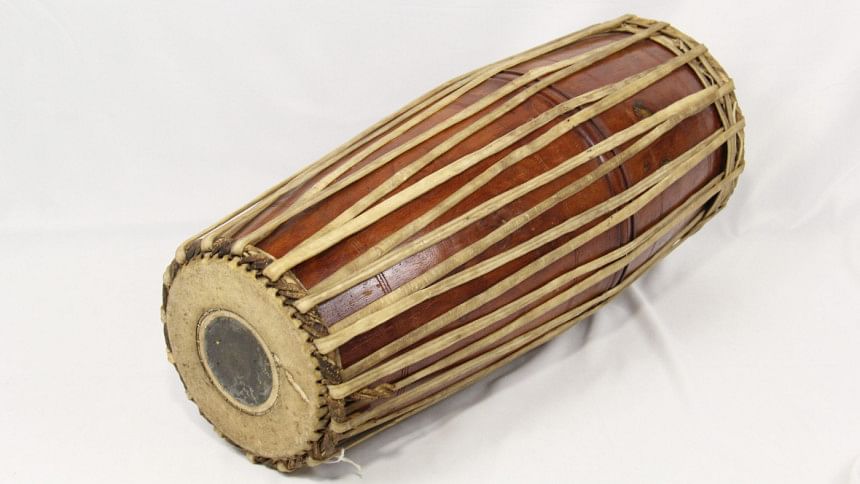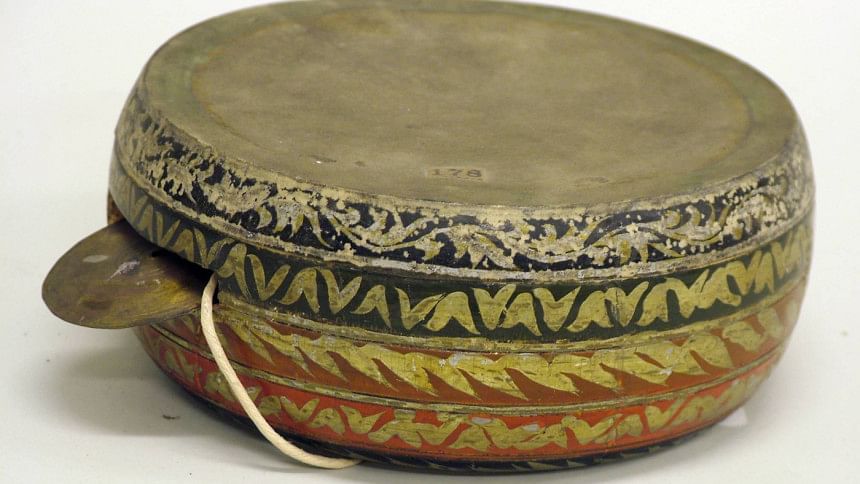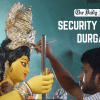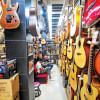The blissful sounds of Puja

Durga Puja, one of the most significant festivals in Bangladesh, is not only a visual spectacle of grand idols and vibrant pandals, but also an auditory experience that accentuates the spiritual and cultural essence of the celebration. While much of the attention during the Puja season is drawn to the artistry of the idols or the grandeur of the festivities, the role of traditional music and instruments remains a deeply rooted, often overlooked aspect. The dhak (large traditional drum), shankha (conch shell), kasor ghanta (brass bell), and other instruments are not merely background sounds—they form an integral part of invoking the presence of the Hindu goddess Durga and binding communities in devotion and celebration.

The dhak holds a special place among all the instruments associated with Durga Puja. This large, double-sided drum, typically played using wooden sticks, is more than just an instrument—it is the pulse of the festival. The moment a dhak starts playing, it stirs an instant connection to Durga Puja in the minds of those who hear it. The deep, rhythmic beats of the dhak set the tone for the rituals, marking the different phases of the celebration—from the unveiling of the idol to the final immersion. Traditionally, dhakis (dhak players) travel from rural Bengal to cities like Dhaka during the Puja season, often passing down their skills from one generation to the next. For them, playing the dhak is not merely a livelihood, but an offering to the goddess herself.

The mridangam, a two-faced drum played with the hands, is widely used in classical and devotional music, especially in bhajans and kirtans dedicated to Durga. In contrast, the khol, which has a similar structure but a more conical shape, produces sharper, higher-pitched tones, adding complexity to the rhythmic patterns in Puja performances. The dholok, a smaller two-headed drum, is commonly played, and its portability makes it a popular choice for accompanying informal singing sessions or traditional dance performances during the festival.

The duggi, a small hand-played drum, is frequently used to add faster-paced, energetic beats to the Puja atmosphere. It is typically played in tandem with the tabla or mridanga, giving a sharper, more rhythmic depth to the ensemble. The khamak, a tensioned instrument that can create modulated sounds through string manipulation, adds a playful, almost melodic element to the percussion section of Puja performances. The khamak is known for its quirky, pitch-altering capabilities, and its sound often punctuates the more serious rhythms of other percussion instruments, giving a unique texture to the overall auditory experience.

The khonjori is a small frame drum with jingles, played with one hand while the other manipulates the tension of the drum head. Its distinct, sharp sounds accompany folk and devotional songs during Durga Puja, particularly in dance sequences like the Dhunuchi Naach. The instrument's light, cheerful timbre contrasts beautifully with the heavier beats of the dhak and mridanga, creating a balanced and dynamic auditory experience.

The shankha, or conch shell, is yet another iconic sound associated with Durga Puja, particularly during the performance of arti (Hindu ritual) and other religious rituals. Blowing the shankha is believed to purify the environment and call the goddess to manifest her presence. The piercing, resonant sound of the conch serves as a clarion call for the divine, cutting through the noise of daily life to remind people of the sacred moment. Traditionally, blowing the shankha requires significant skill. The shankha is not merely a decorative object, but a functional instrument with deep religious significance. In many households, it is blown not just during Durga Puja but in daily prayers, symbolising auspicious beginnings and the removal of negative energies. During this festival, the sound of the shankha is often accompanied by ululation, a high-pitched sound made by women to express joy and invoke blessings. Together, these sounds create an immersive experience of spiritual and communal unity, as the sharp tones of the shankha and ululation contrast with the deep, resonant beats of the dhak.

Another key instrument is the kasor ghanta, which is often used during the pushpanjali (flower offering) and arti. The steady, rhythmic ringing of these bells creates a hypnotic, meditative atmosphere, helping devotees focus on their prayers. In the hands of a skilled pujari (priest), the bell becomes an instrument of synchronisation, setting the rhythm for the offering of flowers, the lighting of lamps, and the chanting of mantras. The significance of these sounds in Hindu rituals is well-documented. According to ancient scriptures, the vibrations produced by bells and other ritual instruments have the power to cleanse the environment and the mind. The continuous, high-pitched ringing of the kasor ghanta is believed to dispel negative energy and bring clarity to the proceedings.

Any given discussion of traditional Indian percussions would be incomplete without mentioning the tabla. Though not always associated directly with Durga Puja rituals, the tabla often finds its place in musical performances and cultural programmes held during the festival. Its rapid, intricate rhythms bring a sense of classical grandeur to the proceedings.

Despite the central role these traditional instruments play in Durga Puja, there are concerns that their importance is fading in the face of modern musical trends. Increasingly, the soundscapes of Durga Puja pandals are being dominated by film songs, remixed tracks, and high-powered sound systems. While this brings a certain level of entertainment, it also risks diluting the traditional auditory experiences that have defined the festival for centuries.
It is crucial to not only celebrate the visual grandeur of Puja, but also to recognise and honour the auditory traditions that bring Durga Puja to life. Whether you are a devotee, a cultural enthusiast, or simply a curious observer, the next time you hear the rhythmic beats of the dhak or the resonating call of the shankha, remember that these sounds are more than just noise—they are the heartbeat of the festival, echoing through generations.

 For all latest news, follow The Daily Star's Google News channel.
For all latest news, follow The Daily Star's Google News channel. 









Comments